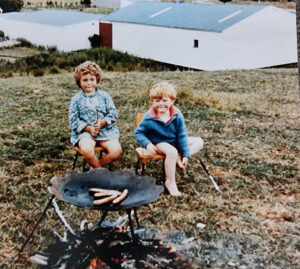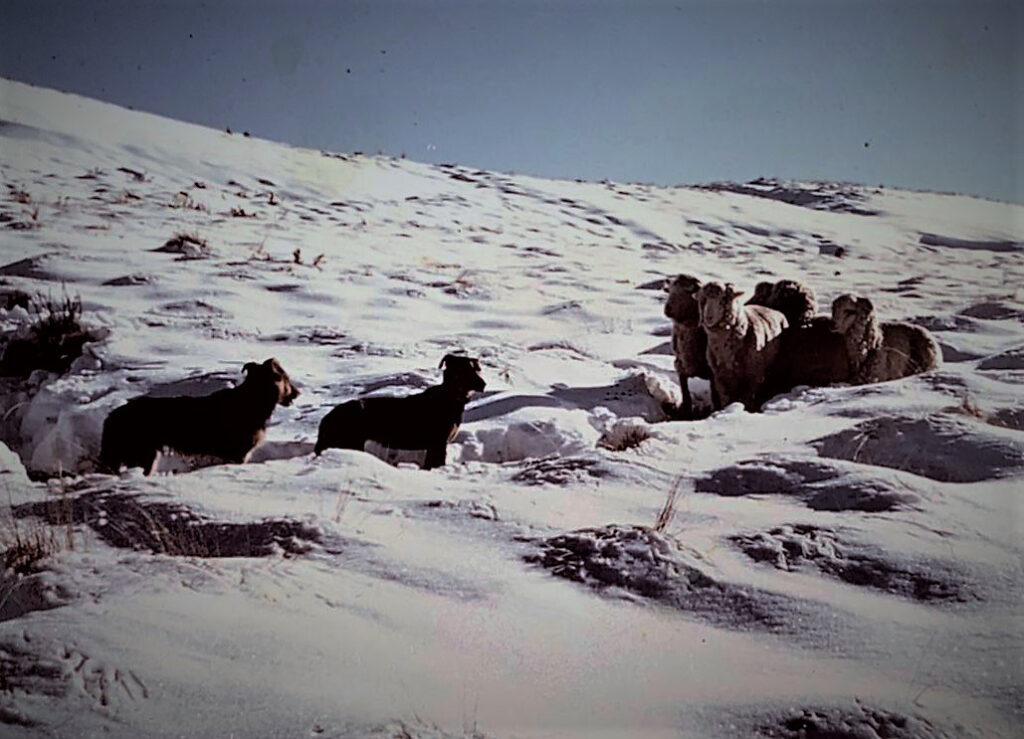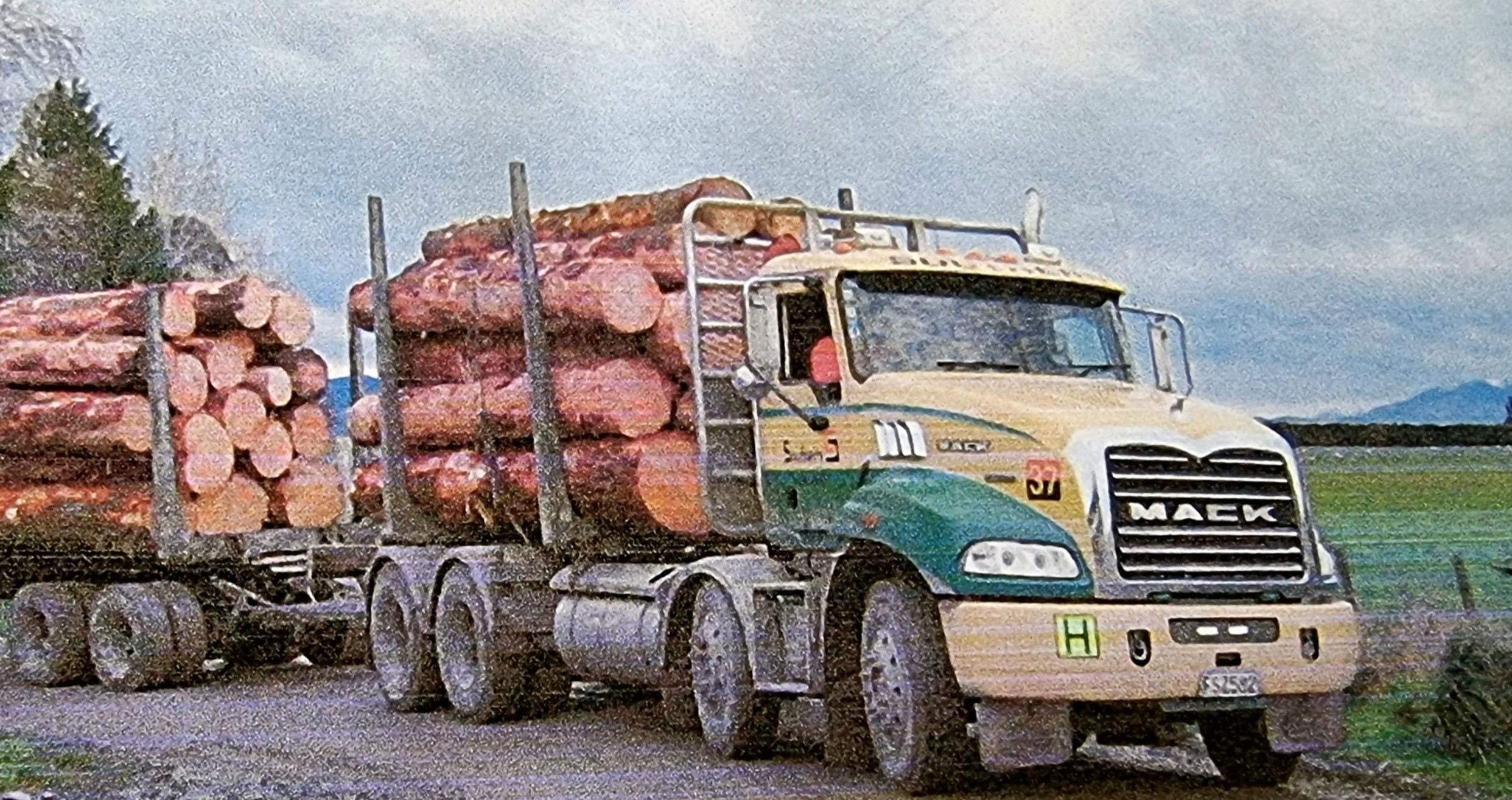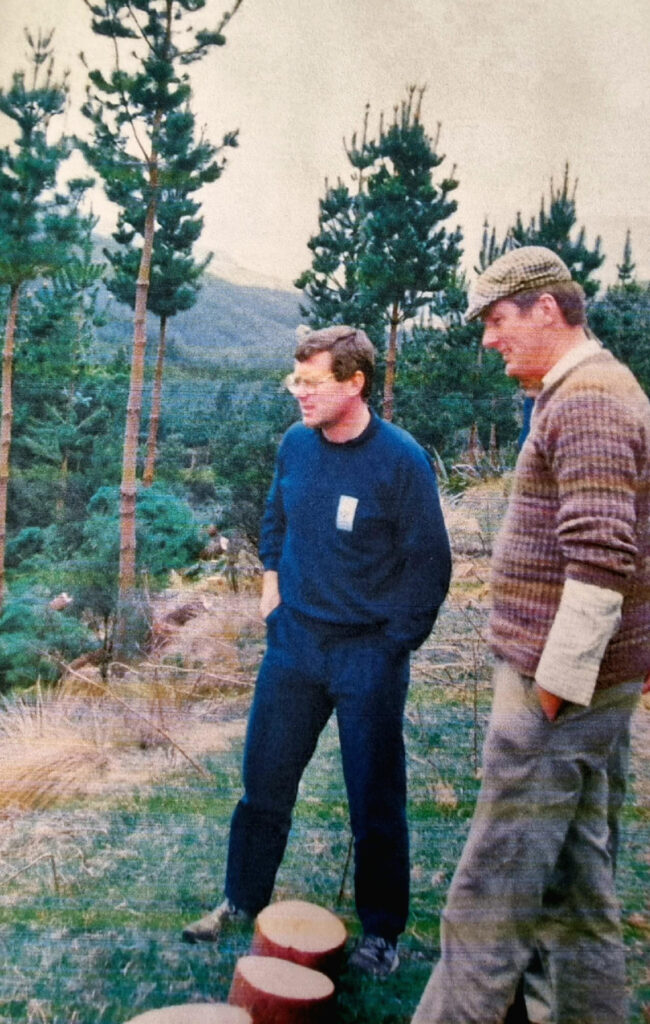1970 was an eventful year for several reasons. We had been farming Cairn Peak for six years, and though heavily burdened with debt, we had continued with our development program and our carrying capacity had increased significantly.
As livestock numbers increased there wasn’t enough fattening land, which meant we had to sell our calves and lambs at weaning instead of letting them grow into profit over the summer months. This meant revenues were rising but profit remained elusive

Joanna and Graeme cooking lunch.
Our young family was growing and Nicola our oldest was in primary school. We had no car, however the farm owned an ancient long wheel base, flat deck Land Rover. The cabin was unlined, unheated, drafty and smelly. On work days it was used for feeding out, carting dogs, picking up dead sheep and attending to maintenance and stock work. On town days, we hosed it down, and together with the two toddlers we’d squeeze into the cabin and head off to Invercargill 60 kilometers away.
Tribulations
Early on May 4th that year I loaded the Land Rover with fencing gear, packed a cut lunch, and headed into the hills to finish a stretch of new fence. I dug in the remaining posts and by mid afternoon the job would have been complete once the final wire was fixed in place. Sadly for me fate intervened and a 20mm staple spun into my eye. My vision was replaced by a swirling kaleidoscope of colour and that was when I became permanently blind in my right eye.
I carried on for another couple of hours, It was important to ensure the fence was stock proof. Finally it was finished and I gingerly made my way down the steep hill track to the homestead. Rosie drove me to the Doctor in Winton. He was visibly moved after he’d examined me and notified the hospital of my need for urgent treatment, but there was no ambulance so we drove back to the farm, packed an overnight bag and set off on the long drive to Dunedin hospital 200 kms away. It was late at night when we arrived, there was a team waiting to operate, and it was daylight when it was all over and I was admitted to the ward. I’d had micro surgery on a lacerated cornea and the remains of my lens was removed. The front of my eye was a mess but the posterior chamber was intact so with luck I wasn’t going to need a glass eye. My troubles weren’t over yet though. I went home but after three weeks I was readmitted with acute glaucoma which required an operation on my Iris. I was discharged again then flown once more to hospital, this time by air ambulance. I now had an acute bacterial infection and a corneal ulcer. I was finally released on July 30th, nearly three months after the accident.
When all was over I was secure in the knowledge that farm staff were covered by our company insurance policy, and permanent loss of the sight of one eye attracted a hefty pay out. I was less smug when it transpired I was deemed an owner by the insurance company and not an employee. They’d weaseled out of paying so I received nothing.
Winter

We’d look for stranded sheep and tramp a path for them to enable them to reach areas where they could walk to lower levels under their own steam. This is called snow raking and is exhausting work.
We had an uncharacteristically severe snowstorm in the winter of 1970 and 500 out of a mob of 1500 wethers on the hill perished. In inclement weather, sheep will run before a storm and can end up in deep snow drifts on the lee side of the hill. If they can’t be reached they can become snowbound and die of starvation or asphyxiation. It’s not uncommon for snowbound sheep as a last resort to eat the wool on each others’ backs.
Neighbours
Bob Mitchell had a long boundary with us on the Dipton flat road. I was told he’d been a hopeless alcoholic but had been rescued by the Jehovah’s Witnesses and was now a devout Christian and a church elder.
He was rough and ready with a friendly demeanor, and was always up for a chat. We’d arrived in the district in 1964 and at that time the Jehovah Witnesses were predicting the end of the world would occur on or before 1969. Bob, too, was convinced, but as he said, “no man can predict the exact hour or the day.”
During the years we were neighbors Bob drove relentlessly around the Southland Provence each year, knocking on Farm doors, handing out the Watchtower magazine, and preaching Armageddon. I admired him immensely for his commitment and his friendliness. His wife and two teenage children were just as amiable but I suspect coping with the ever present dilemma. What could be worse? A run down farm due to Bob’s religious fervor, or a run down farm due to Bob’s alcoholism?
He had an encyclopedic knowledge of the Bible and did his best to recruit me, he yearned to facilitate my redemption. This gave me no option but to pour over the bible at nights searching for quotes to counter his arguments. He had all the answers however and I couldn’t convince him of the futility of frittering the years away while he waited for the world to end. It was stalemate. 1969 came and went, the world didn’t end, and Bob’s conviction remained strong.
Time went by, until the topic of our boundary chats gradually changed. One day Bob said “there’s not much time left, I need to spend the rest of my life witnessing. Would you guys by any chance be interested in buying my farm?” Of course we would! I took the gamble that the world wasn’t about to end, which wasn’t all that difficult. In early 1972 we shook hands over the boundary fence and our solicitors drew up the contracts. For a very fair price we’d acquired 263 acres of rich river silt which totally solved Cairn Peak’s lack of fattening and cropping country. It was a win win at the time, Bob shifted his family to Invercargill and continued with his witnessing, but the world didn’t end and he gradually slumped back into hopeless alcoholism.
The last I heard, Bob’s behavior had gotten out of hand, he was stripped of his leadership role in the church, and only permitted to worship if he remained silent in the seats at the back. A sad end to the dreams of a decent human being.
Cattle Wars
One of our more colourful neighbours was Crafty Burgess; he had a hill country property scaling the length of our Northern Boundary. Crafty’s older brother John had a neat, fully developed flat farm on our Southern boundary, so we had a Burgess to the North and a Burgess to the South and they despised each other. I was told the brothers and their wives hadn’t talked for decades.
Crafty was a returned soldier from the second world war His face was badly scarred possibly by shrapnel. He was a rough diamond and a laugh a minute, but quick to anger when drunk. Unfortunately, he was drunk most of the time.
There’s a snobbery among cattle farmers about the purity of breeding animals that still exists today. In NZ at that time the two most popular beef breeds were Aberdeen Angus and Herefords and opinions were strongly polarised as to which was superior.
As with all domestic animals, pure breeds’ credentials are dictated by breed societies and paramount to this is skin colour, together with other useless characteristics which have no relationship to productvity. Scientists of the day were proving that cross breeding traditional beef breeds with other strains resulted in a trait called hybrid vigour in the progeny. This means that on average the offspring grow faster and kill out at heavier weights when slaughtered. But horror of horrors, even unwanted male calves from much despised dairy herds can outperform traditional breeds once hybrid vigour comes into play.
Crafty was a Hereford man and his prize 18 month Hereford heifers were grazing peacefully in a lush boundary paddock. Heifers if well grown can easily conceive but traditional farmers like Crafty wouldn’t let them near the bull for another year because conception can stunt their growth if the mothers aren’t well fed over the winter months. On the other hand the neighbouring farmer, who I’ll call Jim Davis, was perfectly happy with his mob of mixed breed cattle and in among them was a young dairy bull.
It’s an unwritten rule that bulls are kept away from boundary fences, particularly if, as in this case, the boundary fence isn’t all that robust. You can guess what happened. Picture Crafty looking fondly out his kitchen window early one morning, cup of coffee in hand, admiring his heifers. Suddenly a nondescript young dairy bull heaves himself onto his hind legs, and with a mighty thrust impregnates another heifer. He’s no doubt been busy all night!
No one would have wanted to be near Crafty for the next hour or two but around-mid morning, the phone rang at Dipton Transport, it was picked up by the manager. “yes, what can I do for you.” “Burgess hear” “Yes Crafty how can I help?” “Send over a cattle truck and trailer” “ok when do you want it?” whenever you’re free” ” where are we carting to.”I’ll tell you when you get here.” “ok we’ll be about an hour.” The truck and trailer rig performed the tricky maneuver of backing up the road to the cattle yard where there’s a miserable steer, standing in the race dripping blood. Crafty points to the steer and says” load that mongrel bastard onto your truck” and he brandishes a plastic bag containing two testicles, holds it out and says, “put this into the trailer, take it to Jim Davis and send the invoice to him!” he turns on his heel and stalks off and as far as I know, that was the end of it.
Justice is Done
I sensed that Nick Harrison, one of Cairn Peak’s remaining shareholders had lost enthusiasm for his investment. I offered to pay him the equivalent of his purchase price in return for his quarter share. He accepted with alacrity and early in 1973 the deal was signed. I now owned 50% of the farm. Bill Piercy my remaining partner wasn’t happy. Eighteen months previously he’d gained a coveted majority share by purchasing Bob McCartney’s shares, without signalling his intention to we other partners. Since then I’d chafed at the questionable nature of this transaction but now justice was done. There were two of us left and we were both equal.
Forestry – A New Beginning
In 1968 the NZ Forest Service began promoting a Forestry Encouragement loan Scheme. Approved farmers could get low rate finance to convert marginal land into pine forest and the loans weren’t called in until the timber was harvested.
Once we had been accepted by the Forestry Department as suitable candidates I had a new craft to learn. I enrolled in a Farm Forestry correspondence course and was taught that Pinus Radiata seedlings were planted by hand at approximately 600 stems per acre and selectively thinned to achieve a final crop at a density of 120 per acre. Clear felling took place at around 30 years of age or when the average log diameter was 24 inches at breast height.

30-year-old trees from our Pinnacle Pine Forest syndicate. Replanting then commences, and the whole process starts over.
Pruning was typically undertaken in two lifts during the early years of the crop. The removal of the lower branches at an early age produced a knot free log at least ten feet long. This is ideal framing timber for house building and for the manufacture of furniture. The lower grade timber that towers above the ten foot base logs has a variety of uses, still highly marketable, but selling for a lower price per cubic meter
The forestry industry was a boon to us in that we eventually syndicated , 2,000 acres of our marginal country into commercial forest. Previously it was only suitable for grazing 1 stock unit for every 3 acres.
Syndication
Our first flirtation with forestry, involved the clearing and planting of 106 acres in 1969. All went well so it was time to reap the benefits of our large land bank. I advertised for expressions of interest in a forestry syndication venture. I targeted business people attracted by the tax incentives and had very little difficulty selling unit shares in our first syndicate comprising 860 acres. It was named Benmore Forest Syndicate. Cairn Peak provided the day to day forest supervision at negotiated rates. A committee was elected to handle governance and decision making. It was a great recipe and the syndicate members remained lifelong friends. The planting got underway in 1973 and profitable clear felling commenced 30 years later. This syndicate mostly manned by second generation family members, is now well on the way towards its second rotation harvest
The Pom

Lindsey McIntyre, one of our syndicate members on the left, talking to Mike Smith. At their feet are cross sections of the growing trees. These give an indication of the growth rate.
The history of Cairn Peak and forestry isn’t complete without paying tribute to Mike Smith. Mike comes from the Midlands in the UK. He was living with a family who dealt with horses in the hunting, and show jumping industry and It was there he met his future wife Donna Menlove.
Donna was a Dipton girl overseas to gain experience. Whilst there she’d been a groom for David Broome, a British contender in the 1972 Munich Olympics. The couple married in England and after a short working holiday in Dipton, decided to return permanently. Casual work is reasonably plentiful in farming districts, Mike was resourceful and fitted in extremely well. He had a distinctive north country accent and didn’t quite fit the mould of the local blokes. More than one pair of eyebrows were raised when he first appeared around the district, wearing his Englishman’s tweed peaked cap and a pair of gaiters.
There were two other casual workers we used from time to time (I’ll call them Wes and Clary.) They were planting trees for us and in the Dipton pub one night, I overheard Wes tell someone with a smirk, “the Pom’s going to be planting with us tomorrow; we’ll see what he’s made of.” Tree planting on hill country is an arduous task, but no matter how hard they went at it the next day, the indefatigable Pom kept pace with them. At the end of the day, they had nothing to smirk about!
Wes became a little resentful. Mike didn’t exactly fit their mould, but they continued to work together. After they’d completed our planting job, Wes was asked to supply a quote to John Ruddenklau, another farmer. His price was $3 an hour. and the farmer said, “You’ve just finished planting for Ken Fife for $2.50 an hour. I’m not paying you $3.” Wes held his ground, saying to his mate, “he’ll need us sooner or later.” But the farmer wouldn’t budge. The fact was, at that time, $2.50 was the going rate recommended by the Forest Service. To put this into perspective, I was earning $80 a week to run Cairn Peak.
The upshot was a stalemate, and eventually, Mike formed his own forestry contracting and consulting business which has thrived now for 50 years. In that time, he’s been the driving force in the success of our three syndicates and is one of the most respected forestry experts in New Zealand’s Southland province.
As for Wes and Clary, they never did get that $3 an hour planting job.
In the late 1970s, I accepted a two-year appointment as Ranch Manager for the Uluisaivou Corporation in a remote area of Fiji. I’ll be relating some of my experiences during this period in the next chapter of my story.
Ken Fife
24th May 2022
